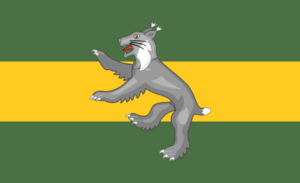Royal Easthampton Borderers
| Royal Easthampton Borderers | |
|---|---|
| REB | |
 | |
| Active | 1890 |
| Country | Arcerion |
| Type | |
| Role | Infantry |
| Size | 1,800 (2026) |
| Part of | 7 Rifle Brigade |
| Garrison/HQ | Larton Barracks, Arcerion Armed Forces Base Easthampton |
| Motto(s) | "Grit and Wit" |
| Engagements | Arcer Bush Wars, First Great War, Second Great War, Final War of the Deluge, Telekonese Conflict, Istrenyan Crisis |
| Commanders | |
| Commanding Officer | LCol Christian MacNulty |
| Regimental Sergeant Major | WO1 Colin O'Lyne |
The Royal Easthampton Borderers is a light infantry regiment of the Arcer Army's Royal Arcerion Infantry Corps. It consists of a number of battalions and garrison units, split amongst both the Regular Force and Reserve/Territorial troops. Each of the Regiment's battalions form part of 7 Rifle Brigade, which is Arcerion's premier light infantry brigade. The Borderers focus on tasks such as mountaineering, air assault, pathfinding, long-range reconnaissance, individual marksmanship, and long-distance patrolling. The Regiment was created in 1890 after an amalgamation of the Easthampton Regiment and the Arcerion Easthampton Borderers, and has remained in its current configuration since it amalgamated the Arcerion highland Infantry Regiment which disbanded and re-badged to the Borderers in 1919. The Borderers are widely considered in Arcerion to be the premier light infantry Regiment in the Army, and are respected in Crona and Ixnay as world-class experts in alpine warfare and dismounted infantry operations.
The Regiment is headquartered at the Larton Barracks, Arcerion Armed Forces Base Easthampton.
History
Early History
The Regiment was stood up in 1890, when the Arcer General Staff released orders to collapse the two existing regiments in the eastern part of Moorden Governorate into a singular formation. The existing Eashampton Regiment, initially formed in 1840, as well as the Arcerion Easthampton Borderers which had been stood up in 1867 were collapsed and given the honorific 'Royal,' owing to their exemplary service policing the border areas in Washakara. The Regiment participated in the Third Bush War, helping to secure frontier settlements and battle native incursions into the Arcer Heartland.
The Regiment saw major action in the Defense of Easthampton during the First Great War, where it defended the city of Easthampton from Paulastran troops, and was engaged heavily in trench warfare and modern methods of fighting, including the use of modern machineguns, infantry mortars, and early wireless radio sets. Shortly after the end of the First Great War, the Arcer General Staff began to disband the total amount of Regular Army infantry units, and two battalions from the Arcerion Highland Infantry Regiment re-badged to the Borderers as part of this force restructuring.
Early Modern History

The Regiment deployed as part of the Arcer government's effort to aid the failing Royal Government of the Kingdom of Ardmore during the Ardmori Civil War. It participated in a number of battles against communist forces, and during the Battle of Elliston was awarded one of the final battle honours in the Arcer Army by the King of Ardmore for its successful assault against communist forces in the hills around the strategically important crossroads town. The Borderers played a key role during the withdrawal to the North Island during Operation Smatter (also called the Battle of the Southern Marches), where the 2nd and 4th battalions marched seventy kilometers while in close contact with the enemy.
During the Second Great War, the Borderers were heavily involved with the invasion of The Cape as part of Operation Lightfoot. The Regiment saw action throughout the duration of the conflict, and helped fight to the outskirts of Cape Town as part of Operation Severance. During this time, the Regiment's experience in complex terrain fighting helped immensely, as the mountainous and hilly terrain of the Southern portions of the Capetian peninsula made it difficult for fast-moving mechanized formations to maneuver, and the ground favoured elite mountain troops such as the Borderers. The Regiment withdrew in good order at the end of the war after two successful campaigns.
Occidental Cold War
1980 creation of 7 Rifle Brigade Istrenyan Crisis
Telekonese Conflict
Post-2000s
Final War of the Deluge 2022 Confederate Memo on Defence